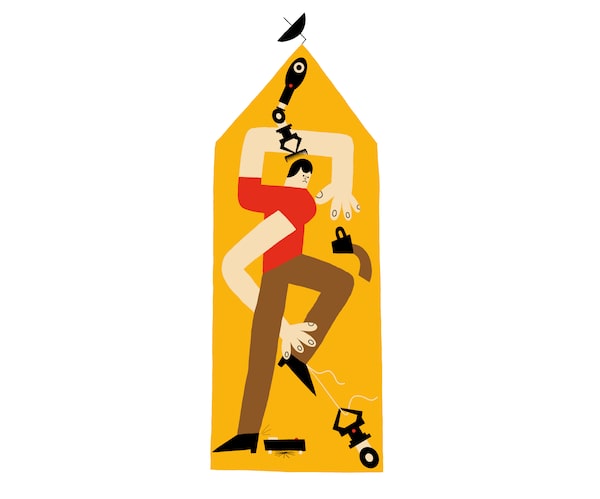
Many early adopters of smart technology are taking stock of whether the glut of gadgets really improves their livesIllustration by Miguel Monkc
In the early 2000s, having a smart home likely meant you had installed a few discrete speakers in your ceiling that blasted Chopin throughout your house.
We then entered the DIY era of home tech, a phase defined by WiFi-connected gadgets from smart light bulbs to robo-vacuums, and voice assistants such as Alexa and Google Home. Many of these novelty products ended up being more like paperweights than problem solvers. “I’ve tested a few fancy kitchen gadgets that are now just heavy pieces of plastic and metal because the company went under and there are no controls on the device itself,” says Jenny McGrath, a tech reviewer at Insider. A particularly sobering survey found U.K. households have accumulated over $114.5-billion worth of unused devices.
Today, it’s not this clutter of gizmos that is pushing the smart home tech industry forward, nor are they what Canadians are most keen on. We’re seeing a rise in the production of big-ticket smart home appliances and fixtures, such as app-controlled ovens that can turn themselves off, or bathtubs you can fill from your phone on your drive home from work.
According to Steve Koenig, a vice-president of research at the Consumer Technology Association, data show that Canadians are taking a particular interest in “healthy home technologies” such as air and water purifiers, as well as monitors that promise to pay for themselves by reducing energy costs. Smart home devices are also enjoying increased appreciation as tools that can help seniors live in place by making their homes safer, and that can allow people with different speech, mobility and motor needs to live more comfortably.
Anyone who’s bought a smart home operating system such as a Google Home or an Apple HomeKit knows that these setups are often only compatible with certain products, and if you’re buying a patchwork of tech from a broad range of companies, it can result in needing more and more apps on your phone to wrangle robots that don’t play well together. New products, such as Matter, a buzzy system that debuted at the 2023 Consumer Electronics Show in Las Vegas, promise to streamline doodads from different makers and allow users to operate everything from one master control system. The smart home industry’s long-term aspiration for interoperability may finally be coming closer to fruition.
What interoperable tech is nudging us toward is the ideal of “ambient technology,” a hallowed vision of seamless integration that could make our lives finally look like an episode of The Jetsons. Canadian development company Brookfield Residential has been working on integrated, ambient tech homes for over five years, partnering with Amazon to develop a branded Smart Home development tricked out with amenities including a drone helipad and a drop zone for package deliveries.
The project caught the eye of Dr. Heather Suzanne Woods, a researcher at Kansas State University, whose upcoming book is about the cultural effects of mass-produced smart homes. At this pivotal point in their history, does she believe we all should aspire to live in one? “Right now, the smart home is powerful because it has this allure of technology; the idea of optimizing one’s life, of increasing leisure time, of maintaining safety and security, these are all luxury items,” Woods says. Yet, should companies fail to fully mitigate the harms of smart homes, such as the potential for invasive data collection and security threats, “there might be a reverse where people are less convinced that a particular device can provide all of these big lofty luxuries,” she says. “And in fact, it’s human contact, care and support that’s a luxury item.”
The promise of a seamless, fully connected domestic life can be exciting, but it is functionality – how tech solves problems in your life – that’s more salient than buzz. The most important question about these new products is one we can only answer individually: How smart do I want my home to be?